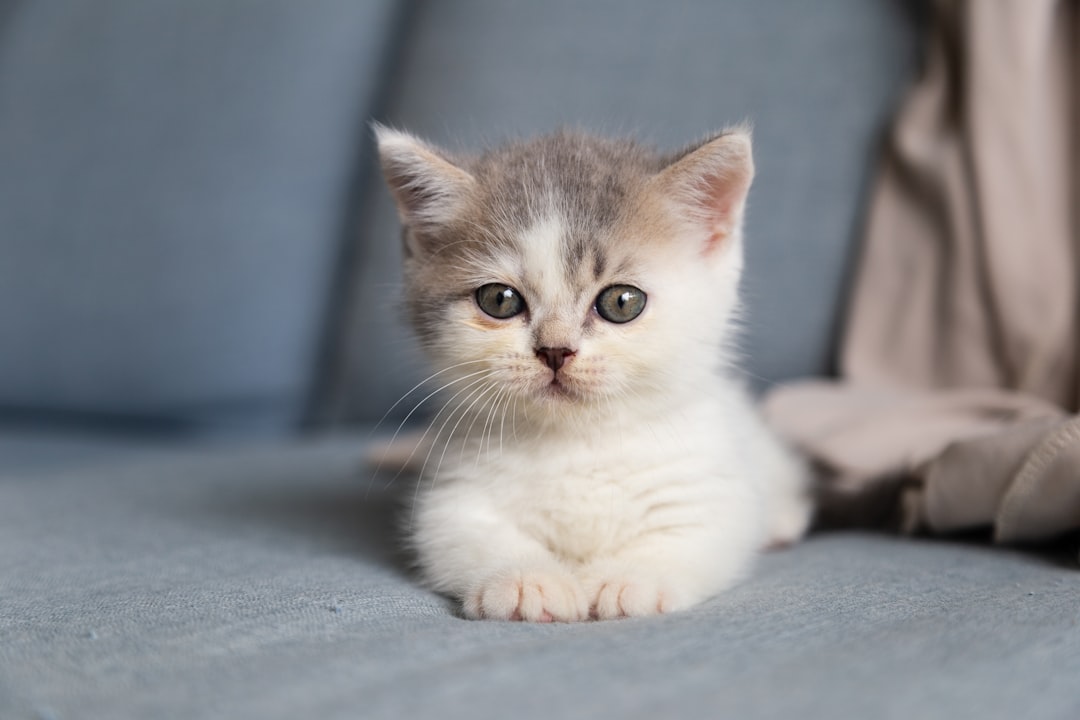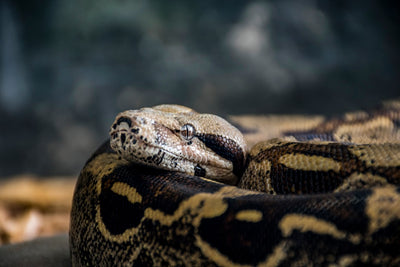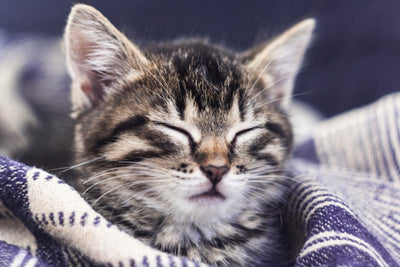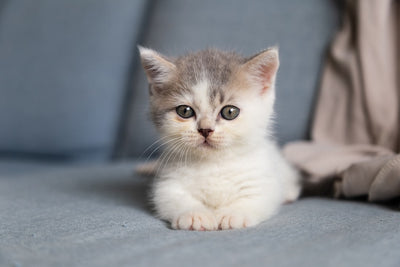Key Takeaways:
- Introduction
- Nutritional Needs of Kittens
- Benefits of Wet Food
- Key Ingredients to Look For
- Ingredients to Avoid
- Understanding Labels and Certifications
- Choosing a Brand
- Transitioning Your Kitten to Wet Food
- Feeding Guidelines and Portions
- Common Myths About Wet Food
The Importance of Wet Food in Your Kitten's Diet
Why Choose Wet Food for Kittens?
Wet food for kittens plays a vital role in their growth and overall health. Unlike dry kibble, wet food typically contains a higher moisture content, which is essential for maintaining hydration, especially in the early stages of a kitten's life. This is particularly critical as kittens are prone to dehydration, which can lead to serious health issues. Additionally, the enticing aroma and flavor of wet food can stimulate a kitten’s appetite, making it an excellent choice for picky eaters.
Nutritional Benefits of Wet Food
When discussing the best kitten food, it’s crucial to emphasize the nutritional profile of wet food. It generally contains more protein and essential nutrients that cater to a kitten's developmental needs. Wet food formulations are often enriched with vitamins and minerals necessary for bone growth and muscle development. Furthermore, high-quality wet food options provide an excellent source of carbohydrates and healthy fats, which fuel a kitten's energetic lifestyle.
Transitioning to Wet Food
For new kitten owners, knowing how to properly introduce wet food is important in choosing kitten food. It's advisable to start by mixing a small amount of wet food with their current diet to ensure a smooth transition and avoid digestive upset. As kittens adapt, you can gradually increase the wet food ratio. This strategy not only helps kittens adjust but also enhances their acceptance of various flavors and textures.
Wet Food vs Dry Food: A Balanced Approach
While wet food should be a staple, it’s beneficial to consider a combination of wet and dry options for optimal kitten nutrition. This holistic approach provides the moisture benefits of wet food alongside the dental benefits of dry kibble. An effective kitten nutrition guide will suggest a balanced diet that includes both types of food, allowing for varied taste experiences and nutritional diversity.
Final Thoughts on Kitten Diets
Ultimately, the choice of wet food for your kitten is crucial to promote a healthy start in life. Selecting the right products based on nutritional needs, flavor preferences, and quality will ensure your furry friend grows up strong and healthy. Page through our upcoming sections to learn more about specific brands, flavors, and tips to keep your kitten happy and nourished!
Nutritional Needs of Kittens
As you explore the essentials of choosing kitten food, understanding the specific nutritional needs of kittens is crucial for their healthy growth and development. Kittens have unique dietary requirements that differ significantly from adult cats, and including the right balance of essential nutrients is key to ensuring your little furball thrives. Here’s a detailed breakdown of vital nutrients your kitten needs:
Proteins
Proteins are the building blocks of your kitten's body. They play a critical role in muscle development, immune function, and overall health. Kittens require a high-protein diet as they are in a rapid growth phase. Ensure that the chosen wet food for kittens contains quality protein sources such as:
- Chicken
- Turkey
- Fish
- Lamb
Look for a food that lists these proteins as the first ingredient for optimal nutrition. The general guideline is that the protein content should be around 30-40% of their diet.
Fats
Fats are just as important in a kitten’s diet as proteins. They are a significant energy source and essential for brain development and coat health. Look for healthy fats like:
- Fish oil
- Chicken fat
- Flaxseed oil
A proper balance of fats, approximately 20-30% of their total diet, will aid in healthy growth and development. Healthy fats also contribute to a shiny, lustrous coat.
Vitamins
Vitamins play vital roles in the metabolic processes of kittens. Vitamins such as A, D, E, and several B vitamins are essential for numerous body functions, including the support of the immune system and vision health. It’s crucial to select the best kitten food that contains a complete range of vitamins. Key vitamins include:
- Vitamin A - for healthy vision and skin
- Vitamin D - for calcium absorption and bone health
- Vitamin E - an important antioxidant
- Thiamine (Vitamin B1) - crucial for nerve function
Minerals
Minerals are crucial for various bodily functions, including bone formation and metabolism. Important minerals for kittens include:
- Calcium
- Phosphorus
- Potassium
- Iron
A balanced ratio of these minerals is essential for bone health and overall development. Make sure that any wet food you choose contains the right proportions to support kitten nutrition.
When considering your kitten's diet, always consult with your vet to ensure you’re meeting their individual needs and selecting the healthiest options available. With the right combination of proteins, fats, vitamins, and minerals, you can provide your kitten with the foundation for a long, healthy life.
Benefits of Wet Food for Kittens
Hydration Support
Hydration is crucial for your kitten's overall health, especially during their growing phases. Unlike dry kibble, wet food for kittens contains a high moisture content, typically around 70-80%. This added hydration helps your little furball maintain proper kidney function and aids in digestion, reducing the risk of urinary tract issues. By including healthy wet cat food in your kitten's diet, you're not just offering a meal; you're ensuring they stay hydrated and healthy.
Incredible Palatability
Most kittens are notorious for being picky eaters, but wet food offers an enticing aroma and texture that can appeal to even the fussiest of eaters. The rich flavors often found in the best kitten food options can promote better eating habits and help ensure that your kitten receives all the essential nutrients needed for proper development. When they're excited to eat, it makes mealtime a joyful experience for both you and your pet!
Better Digestibility
Wet food for kittens is not just easier to chew; it is often easier to digest as well. The moisture-rich content helps break down food more easily in your kitten's stomach, promoting better nutrient absorption. Compared to dry food, kittens that consume wet food generally experience fewer digestive issues, leading to healthier growth. If you're navigating choosing kitten food, prioritize quality wet food options that are designed specifically for young cats.
Comparison of Wet and Dry Food
| Feature | Wet Food | Dry Food |
|---|---|---|
| Moisture Content | 70-80% | 10-12% |
| Palatability | Very High | Moderate |
| Digestibility | High | Lower |
| Storage | Needs refrigeration after opening | Easy to store |
When considering the best kitten food options for your furry companion, make sure to weigh these advantages seriously. The high moisture and nutrient-rich profiles of wet food can significantly contribute to your kitten’s health and longevity, enabling you to raise a vibrant, active cat. Explore the different types available, and pay attention to specific ingredients that cater to your kitten's unique needs.
Conclusion: Start with Wet Food
In summary, the decision to incorporate healthy wet cat food into your kitten’s diet can lead to numerous benefits, from enhanced hydration and increased palatability to improved digestibility. Armed with this kitten nutrition guide, you now have the insights to make informed decisions that support your kitten's health and happiness. Engage in this important journey of nurturing their growth, and remember: happy feeding leads to a happy kitten!
Key Ingredients to Look For
When it comes to choosing kitten food, understanding the ingredients list is crucial. The right selection can make a significant difference in your kitty's growth and vitality. As you explore various options for wet food for kittens, pay close attention to these essential components that not only nourish but also ensure your little friend thrives.
Real Meat as the First Ingredient
One of the most important factors in selecting the best kitten food is to look for real meat listed as the first ingredient. Meat provides the essential proteins and amino acids that are critical for kittens' development. For instance, ingredients like chicken, turkey, or fish should be prioritized over vague terms like "meat by-products". As kitten nutrition experts often note,
The quality of protein sources can significantly impact your kitten’s health and energy levels.Choosing healthy wet cat food with recognizable meat sources ensures you are providing your furry friend with the building blocks they need for strong muscles and overall growth.
Wholesome Vegetables
In addition to animal proteins, high-quality wet cat food for kittens should include a selection of wholesome vegetables. Ingredients such as carrots, peas, and pumpkin contribute essential vitamins and minerals that support a kitten's immune system and digestive health. The presence of these vegetables not only enhances the nutritional profile but also provides fiber, which is important for maintaining gut health. Including findings from experts in kitten nutrition guides can help owners ensure a balanced diet—making vegetables a crucial component of your kitten’s dietary needs.
Absence of Fillers and Artificial Additives
Lastly, steer clear of foods that list fillers as their main components. Ingredients like corn, wheat, and soy are often used to bulk up the food but provide little nutritional value. Quality brands of wet food for kittens should focus on wholesome ingredients without artificial preservatives, colors, or flavors. These additives can lead to health issues and do not contribute to your pet's well-being. As cat nutritionists advise, “
When in doubt, choose the food that’s as close to nature as possible—free from unnecessary fillers, your kittens will flourish.” By selecting premium, natural ingredients, you can set the foundation for a healthy life for your beloved kitten.
In summary, vital components to look for in the best kitten food include real meat, wholesome vegetables, and a careful avoidance of fillers and artificial ingredients. Ensuring these elements are present in your kitten’s wet food will lead to better health outcomes and a happy, playful companion.
Ingredients to Avoid in Wet Food for Kittens
Artificial Preservatives
When considering wet food for kittens, it’s essential to examine the ingredient list for harmful additives like artificial preservatives. These substances, such as BHA, BHT, and ethoxyquin, are commonly used to enhance shelf-life but can pose significant health risks. Research suggests that these chemicals may contribute to health issues over time, including kidney and liver damage. Opting for products that use natural preservatives, like tocopherols (vitamin E), is a safer choice for your kitten’s nutrition.
Artificial Colors
Artificial colors enhance the visual appeal of pet food, making it more appealing to pet parents rather than the pets themselves. Ingredients such as Red 40 or Yellow 5 have no nutritional value and can lead to sensitivities and hyperactivity in some animals. When selecting the best kitten food, prioritize natural colorants, such as beet juice or spinach powder, which provide a visual appeal without the artificial additives.
Low-Quality By-products
Understanding the source of protein is crucial in your kitten nutrition guide. Many commercial wet foods contain low-quality by-products—fly-by-night ingredients that may confuse conscientious pet owners. Terms like "meat by-products" or "animal fat" may indicate low-quality sources that lack the essential nutrients kittens need to thrive. Look for products that list specific meat sources, such as chicken or fish, ensuring a high-quality protein content that promotes healthy growth and development.
Grains and Fillers
While some kittens tolerate grains, a diet high in grains and fillers can lead to nutritional imbalances and obesity. Ingredients like corn, wheat, and soy are often touted as inexpensive fillers that do little to provide the nutritional value needed. A high-quality wet food will prioritize animal protein and healthy fats, allowing your kitten to flourish as they grow. Always verify that grains are not the primary ingredient in the chosen product.
Sugar and Sweeteners
Another ingredient to watch for is sugar and artificial sweeteners. These additives can lead to unhealthy weight gain and even diabetes in cats. When choosing healthy wet cat food, look for options labeled as low in sugar or devoid of any added sweeteners. Instead, aim for natural flavorings like chicken broth or fish to entice your kitten’s appetite.
By being diligent and assessing the ingredient lists of wet food for kittens, you can make informed choices that prioritize your kitten’s health. Steering clear of these harmful ingredients is a crucial step in ensuring your furry friend receives the best possible start in life. Remember, the right food sets the foundation for a healthy and energetic kitten!
Understanding Labels and Certifications
As a devoted kitten owner, choosing the best kitten food means understanding how to navigate the often complex world of pet food labels. These labels are your roadmap to ensuring your furry friend receives the healthy wet cat food they deserve. Let’s delve into the essentials of reading these labels effectively.
Deciphering Nutritional Information
The first step in understanding pet food labels is to pay close attention to the nutritional information. Look for a clear breakdown of the main components:
- Protein: Kittens require a diet high in protein for proper growth and development. Look for meat or fish listed as the first ingredient.
- Fats: Essential fatty acids contribute to healthy skin and a shiny coat. Ensure the food contains a balance of fats, typically around 20-30% for kitten formulations.
- Carbohydrates: While not as vital as protein, some carbohydrates can provide energy. However, opt for those that come from whole foods rather than fillers.
"A great rule of thumb is that the first five ingredients should include a source of protein." - Veterinary Nutritionist
Understanding AAFCO Guidelines
The Association of American Feed Control Officials (AAFCO) plays a crucial role in setting guidelines for pet food manufacturers. Labels indicating that a product meets AAFCO standards ensure that the food has undergone testing for nutritional adequacy. Look for phrases such as “formulated to meet AAFCO standards” or “complete and balanced” to ensure you are providing quality nutrition.
Quality Assurance Certifications
Another important aspect of reading labels is recognizing quality assurance certifications. These certifications often signify that the food is produced under strict safety and quality protocols:
- FDA Approval: While not all pet foods require FDA approval, those that do typically adhere to more rigorous safety standards.
- ISO Certification: This means the pet food company follows international standards for quality management.
"Seeing a certification seal on your kitten's food can often provide peace of mind regarding its safety and nutritional value." - Pet Nutrition Expert
Reading Between the Lines: Filler Ingredients
As you explore the ingredient list, be cautious of filler ingredients. These may include non-nutritive substances like corn and wheat that do little for your kitten’s health. Instead, focus on brands that prioritize natural ingredients and proteins, ensuring they align with a kitten nutrition guide aimed at fostering optimal growth and development.
Remember, by familiarizing yourself with how to read pet food labels, you're better equipped to make informed decisions about the wet food for kittens you choose. Investing the time to understand nutritional content and certifications can lead to healthier choices for your beloved pet and ensure they thrive in their early years.
Choosing a Brand
As you embark on the journey of selecting the best kitten food, choosing the right brand is just as crucial as the actual food you decide on. The pet food market is saturated with options, but not all brands prioritize the health and well-being of our feline friends. Here are some tips on researching and selecting reputable brands that focus on kitten nutrition.
Evaluate Brand History
One of the best ways to start your research is to look into the brand history. Reputable brands often have years of experience in the pet food industry and a commitment to quality. Check if they have been recalled in the past and how they handled those situations. A transparent brand will openly share their history, including any past controversies.
Assess Transparency
Transparency is another critical factor when choosing a kitten food brand. Look for companies that provide detailed information regarding their ingredients, sourcing, and manufacturing processes. Brands that are proud of their products will readily share this information. Check their website for access to ingredient sourcing and production standards, ensuring they prioritize high-quality materials.
Read Customer Reviews
Customer feedback can be highly enlightening. Websites like forums and product review sites often contain valuable insights that can help in making an informed decision. Pay attention to both positive and negative reviews to gauge how the food has affected other kittens. What do pet parents say about their kittens' reactions to the food? Has it led to health improvements or issues?
| Brand | Years in Business | Transparency Score | Customer Rating |
|---|---|---|---|
| Brand A | 20 | High | 4.8/5 |
| Brand B | 10 | Medium | 4.5/5 |
| Brand C | 15 | High | 4.7/5 |
This table illustrates some top brands and what to look for while choosing a brand for healthy wet cat food. The ratings represent cumulative customer feedback based on experience and product satisfaction. A higher score in transparency indicates that the brand is proactive in sharing their practices with consumers.
Check for Veterinary Recommendations
Finally, seeking out vet recommendations can provide an additional safety net. Veterinarians often have insights into which brands are reliable and effective for a kitten's diet. Consult with your vet to see if they recommend any specific brands or have concerns about others.
In summary, choosing the right brand for your kitten involves careful consideration of various factors including history, transparency, and consumer feedback. By following these tips, you’ll be better equipped to select a brand that prioritizes the health and happiness of your new furry companion.
Transitioning Your Kitten to Wet Food
Introducing your kitten to wet food for kittens can be an exciting journey toward establishing a balanced diet that promotes their growth and overall health. Whether you’re shifting from dry food or another type of diet, the key to a successful transition lies in your approach. Here we explore practical steps that you can take to make this change as smooth as possible.
Start Slowly
Gradual changes are essential when choosing kitten food for your pet. Sudden shifts can upset their stomach and lead to digestive issues. Here’s how to start:
- Begin by mixing a small amount of wet food into their regular dry food. A good starting ratio is about 25% wet food to 75% dry food.
- Over the course of a week, gradually increase the proportion of wet food while decreasing the dry food until the transition is complete.
- Monitor your kitten for any signs of discomfort or allergies as you make the adjustments, and consult your vet if necessary.
Maintain a Consistent Feeding Schedule
Consistency is key when it comes to your kitten's nutrition. Establish a regular feeding schedule that includes wet food to help them develop a routine. Here are some tips:
- Feed your kitten at the same times each day to encourage their appetite and excitement for both the best kitten food and feeding times.
- Keep the feeding environment quiet and calm to make your kitten feel safe while they explore their new food.
- Observe their eating habits and adjust portions according to their needs, ensuring they receive the right nutrition and not overeating.
Choose the Right Wet Food
Healthy wet cat food should contain high-quality ingredients that support your kitten’s growth. Look for options that:
- List a high-quality protein source as the first ingredient, ensuring your kitten receives the necessary nutrients.
- Are specifically formulated for kittens, as they have different nutritional requirements than adult cats.
- Do not contain artificial preservatives, fillers, or by-products, ensuring a wholesome diet.
Be Patient and Observe
Every kitten adjusts at their own pace, so patience is essential. Watch for:
- Any preferences for certain flavors or textures, which can guide future food choices.
- Signs of satiety or dissatisfaction, reflected in their eating habits.
- Behavioral changes, indicating if they are comfortable with the new diet.
Transitioning your kitten to a new diet can be a straightforward process when approached with care. By following these tips and ensuring a gradual introduction to wet food for kittens, you can positively impact their health and happiness.
Feeding Guidelines and Portions
Understanding Portion Sizes
When it comes to providing your kitten with the best kitten food, understanding portion sizes is crucial for their healthy nutrition. Kittens have specific dietary needs that change as they grow. Typically, you should aim to feed kittens wet food for kittens that is high in protein and fat, as they require more energy than adult cats.
A general rule of thumb is to offer about 1 ounce of wet food per pound of body weight each day. For instance, if your kitten weighs 3 pounds, you should feed them approximately 3 ounces of food daily. However, it’s essential to adjust these portions based on your kitten's activity level and growth rate.
Feeding Schedules
Establishing a consistent feeding schedule for your kitten is equally important. Young kittens should be fed four meals a day, spaced out evenly to maintain energy levels and prevent over-eating. As they grow, you can gradually reduce their meals to three times a day.
It is also beneficial to monitor how much food your kitten consumes at each meal. If they consistently leave food behind, consider adjusting your portion sizes to avoid waste. Conversely, if they clean their bowl every time, you might want to reassess the quantity you’re offering.
Adjustments Based on Age and Weight
As your kitten grows from a small, playful ball of fur to a more active young cat, their nutritional requirements will change. Kittens aged 4 to 6 months will generally need around 2-3 ounces of wet food per meal, while those around 6 to 12 months may do well on 3-4 ounces at each feeding.
Always adjust portions based on your kitten’s size and breed. Larger breeds, such as Maine Coons, may need more food compared to smaller breeds like the Singapura. Regularly weighing your kitten will help you determine if they are at a healthy weight, allowing you to adjust their daily intake as needed.
Considering Activity Level
Another vital aspect to consider is your kitten's activity level. Highly active kittens will require more food to maintain their energy levels. For instance, if your kitten spends a lot of time playing or exploring, consider increasing their portions slightly.
Similarly, if you notice your kitten becoming more sedentary, perhaps due to a change in their environment or health, it may be a sign to reduce portion sizes accordingly. Balancing their food intake based on activity levels will help in ensuring your kitten maintains a healthy weight, aiding their development and overall well-being in the long run.
Following this kitten nutrition guide will set you on the right path to ensuring your furry companion thrives. Remember, every kitten is unique, and monitoring their needs is key to finding the right balance in their diet.
Common Myths About Wet Food for Kittens
Myth 1: Dry Food is Better for Dental Health
One of the most persistent beliefs among cat owners is that dry food is better for dental health. While it’s true that some dry kibble can aid in reducing plaque buildup due to its crunchy texture, this is not a one-size-fits-all solution. In fact, studies have shown that the most effective way to maintain oral hygiene in kittens is through regular dental care, including brushing their teeth and providing dental treats specifically designed for this purpose. Wet food for kittens, including healthy wet cat food, is often overlooked despite its essential nutrients that promote overall health.
Myth 2: Kittens Will Become Spoiled if They Eat Wet Food
Many worry that introducing wet food for kittens will spoil their pets or make them picky eaters. This myth is largely unfounded. In reality, feeding your kitten a balanced diet of both wet and dry food can provide a diverse nutrient profile that supports their growth and development. When choosing kitten food, it's important to focus on the nutritional value rather than fixating on perceived spoilage. A varied diet helps kittens enjoy their meals while ensuring they receive the necessary vitamins and minerals critical for their well-being.
Myth 3: All Wet Foods are the Same
With so many options in the market, it's easy to think that all wet foods are created equal. However, not all best kitten food selections offer the same quality. When exploring the world of wet cat food, pet owners should read the ingredients carefully. Look for high protein content, few fillers, and essential nutrients tailored for kittens. Following a kitten nutrition guide can help you choose the best brands that will nourish your growing feline friend effectively.
Myth 4: Wet Food is Just a Treat
Another common misconception is that wet food for kittens should be viewed as a treat rather than a staple in their diet. On the contrary, wet food can be a vital part of your kitten's daily nutrition. The water content in wet food helps keep your kitten hydrated, which is crucial for their kidney health, especially as they grow. This makes incorporating wet food into their regular meals a practical choice for promoting overall health, rather than simply an occasional indulgence.
Conclusion
By debunking these common myths about wet food, we can better understand the benefits it brings to our kittens. Remember that choosing the right food and maintaining a diverse diet will contribute significantly to your kitten's health and happiness. Armed with this knowledge, you can make informed decisions that ensure your feline furball thrives!
Conclusion
Choosing the right wet food for your kitten is a crucial step in ensuring their long-term health and happiness. Throughout this guide, we've covered essential factors that play a significant role in making an informed decision about the best kitten food. From understanding kitten nutrition to evaluating specific ingredients, every detail matters.
Remember, selecting healthy wet cat food can influence your kitten's growth, coat condition, and overall vitality. Each brand and formula offers unique benefits, so it's important to assess your kitten's individual needs. The right choice can foster a strong foundation that enhances their quality of life and nurtures their playful spirit.
As you embark on this journey of selecting the best wet food for your kitten, reflect on the nutritional guidelines shared and consider consulting with a veterinarian if you have any doubts. The welfare of your furry friend is paramount, and investing time to read labels and choose wisely will pay off significantly in the long run.
Take action today: Arm yourself with knowledge, and make thoughtful decisions regarding your kitten’s diet. Your little companion deserves the best, and every meal contributes to a lifetime of health. Happy feeding!
FAQs
What is the best wet food for kittens?The best wet food for kittens is one that is high in protein and contains essential nutrients for growth. Look for options specifically formulated for kittens, which include healthy wet cat food that supports their developing bodies. Brands that prioritize high-quality ingredients and nutrition are ideal.
How much wet food should I feed my kitten?The amount of wet food you should feed your kitten depends on their age, weight, and activity level. Generally, it’s recommended to provide around 2-4 cans of wet food per day, divided into several meals. Always refer to the feeding guidelines on the package and consult with your veterinarian for personalized recommendations.
Can I mix wet and dry food for my kitten?Yes, you can mix wet and dry food for your kitten to provide variety and enhance their overall diet. This combination can promote hydration and improve acceptance of different textures. Just ensure that both types of food contribute to the overall balance of nutrients outlined in a kitten nutrition guide.
When should I transition my kitten to adult cat food?You should transition your kitten to adult cat food around 12 months of age. At this point, their nutritional needs change, and they require a diet that supports maintenance rather than growth. Gradually mix the adult food with the kitten food over a week to facilitate a smooth transition.
How do I choose the right kitten food?Choosing kitten food is crucial for their health and development. Look for formulas labeled as "complete and balanced" for kittens. The ingredients list should feature high-quality protein sources and essential vitamins and minerals. Always read reviews and consider your kitten's specific needs regarding growth and health.
Is homemade food suitable for kittens?While homemade food can be suitable for kittens, it is essential to ensure that it meets their nutritional requirements. Consult a veterinarian or a pet nutritionist to help you design a balanced diet that includes all the necessary vitamins and nutrients for healthy kitten nutrition.






